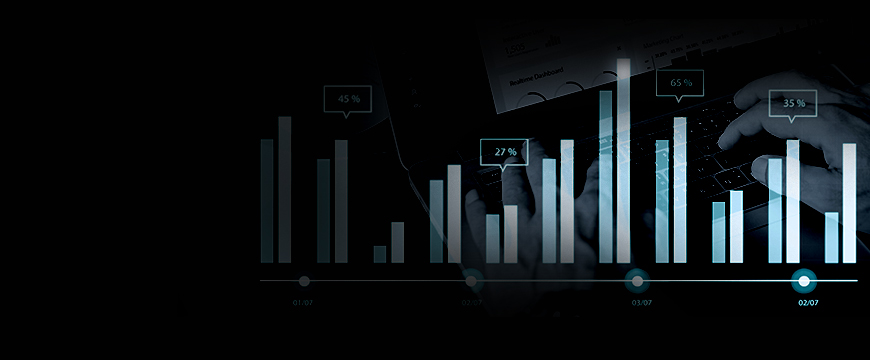With a wealth of data now available, there is no lack of insights to produce. At the same time, having so much data makes it harder to find meaningful insights. Time to deliver value is of essence. Solving complex business problems generally requires data gathering, cleaning, exploring, transforming data and data visualization.
In today's diverse digital landscape, there are multiple data sources to help us better understand our customers and work as a team. Yes, we need more data integration and more advanced analytics skills. At the same time, this opportunity brings companies closer to their customers, reduces their risks and leads to growth and profitability. The good news is that there are ways to deal with this abundance quickly. Power BI is a comprehensive tool that performs all these tasks in the analytical pipeline.
We’re all data-driven now.
We’re all looking for the edge that can get us ahead of the competition.
But, as McKinsey points out, not all businesses can compete. Surges in data caused by rapid digital disruption have not “provided marketers with a substantially better understanding of their customers, because their companies’ outdated data modeling isn’t able to capture these shifts with the necessary granularity and speed.”
This leads to stagnation and a failure to keep up with today’s digital customer.
So, while innovators are leading the way with actionable analytics, others become sluggish. In today's competitive landscape, this means losing market share, and customers, to your competitors. You don't want that.
McKinsey further warns that for companies to take advantage in the digital era, businesses will need to 'update their modeling—from pulling in new sorts of data to retraining algorithms—in order to both keep pace with changing needs and expectations as well as anticipate shifts in customer behavior'.
Jade Global helps clients improve data insights and reporting through BI modernization.
As a certified partner with Microsoft, Oracle, and other leading technology providers, we have helped customers across industries upgrade their infrastructure and BI capabilities to support their organization’s digital transformation initiatives. Let’s discuss about one of our recent transformation initiative for a client using Microsoft Power BI.
In the Fast Lane with Jade Global: BI Modernization Journey Accelerated
The idea of simplifying data analysis and empowering business users is at the heart of Power BI. It was supposed to offer a way for data analysts to share reports and dashboards with their colleagues in a easy manner. And for the most part, this remains true. Companies using Power BI are reporting better insights from it. But it's not completely foolproof; there are still many cases where companies fail to meet their goals within the platform. Jade Global’s deep capabilities across enterprise applications, engineering systems, and different platforms, has helped our clients break free from limitations set by their existing data ecosystems, and achieve unexpected and faster results with BI technologies like Power BI.
In one business scenario where Jade Global helped a client, the client needed rapid data insights. The client’s customer base, customer requirements and product delivery model had changed overnight due to COVID-19. To re-align the business with the new COVID-19 landscape, the client needed to quickly determine labor costs, transportation costs and product costs in the new business model.
The client was faced with two options:
(a) Use the standard approach to export the data from data sources using ETL to a staging warehouse. Then model the data and store in a data warehouse. Then use BI Reporting tools to create dashboards for analytics.
(b) Use Power BI to deliver the solution. There are pros to using the approach (a), however, when time and resources are a constraint or the company has an invested in Power BI, then we explore the approach of delivering quick insights.
In the standard approach, we would need to mobilize several different teams with different skillsets to deliver a solution. For example,
- Data sources -> Staging Database: ETL/ELT Teams - ETL skillset, Informatica, etc. If the data sources are Excel files, which is the case if the data is financial in nature (Balance Sheet, AR, Income Statement, Forecasts, etc), then a lot of logic is in Excel formulas, which requires interaction between IT Teams (technical) and Business Users (business). This is normally assigned to ETL teams.
- Staging Database -> Data Warehouse: SQL Skills, Modelling Skills, Warehousing skills, etc.
Warehousing Team
- Date Warehouse -> BI Analytics – Dashboards: Visualizations, Business Logic, etc.
Analytics – Visualization Team
Delivering a solution involving 3 different teams requiring different skillsets, takes time. In our case, the estimated time to deliver a solution using the standard approach was 6 Months+.
With approach (b) using Power BI as the center of our solution, we utilized Power BI for ETL, modelled the data in Power BI leveraging its modeling capabilities and delivered the dashboards using Power BI. With its wide array of certified connectors, we were able to quickly connect to the different data sources and get going - developing our data model immediately. Using Power BI for all stages allowed us to assemble a development team quickly and keep it nimble. This approach fit very nicely with the Agile delivery model.
Minimizing the interaction points (3 different teams vs 1 team) allowed us to integrate changes and feedback quickly into our data models and business logic. There are a lot of similarities between Excel and Power BI, and this made it easier to incorporate existing business logic from Analyst’s worksheets into Power BI; imagine SQL àDAX to Excel Formulas àDAX.
There is always a business case for approach (a) which is tried and tested. But when faced with challenges, companies now have alternatives.
Our client was able to gather insights within two months and transform its business very quickly.
The problem of managing data is a universal issue that has become even more cumbersome with a growing enterprise and an influx of disparate data sources. Power BI provides a well-equipped platform for data management, analytics, and visualization across various devices, with the ability to be repurposed as per company needs. It has also added new features over time to make it a potent tool for self-service analytics. Its flexibility coupled with ease of use and integration with other tools makes it one of the best BI tools available in the market today. The choice to use this platform or not will depend on your specific requirements
About the Author
Mohammed Sayeed, Power BI Solutions Architect, Enterprise Cloud Apps – Analytics, Jade Global
Mohammad Sayeed has 15+ years’ experience delivering BI solutions to Large and SMB enterprises. Power BI SME having delivered BI solutions leveraging Power BI platform to Hi-Tech industries. Expertise in full analytic workflow - from data preparation, ingestion to insight generation, Power BI Dataflows, Power Query, SSIS, Tableau. He has extensive experience delivering digital transformation and business transformation projects.








